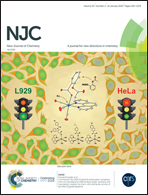Synthesis, characterization and tumor inhibitory activity of a novel Pd(ii) complex derived from methanethiol-bridged (2-((1H-benzo[d]imidazol-2-yl)methylthio)-1H-benzo[d]imidazol-6-yl)(phenyl)methanone
Abstract
In this study, we designed a therapeutic active Pd(II) complex with the new (2-((1H-benzo[d]imidazol-2-yl)methylthio)-1H-benzo[d]imidazol-5-yl)(phenyl)methanone ligand in good yield. The structure of the ligand and its Pd(II) complex was characterized via IR, UV-visible, 1H-NMR, 13C-NMR, mass spectroscopy, TGA and powder XRD techniques. The spectral data of the Pd(II) complex indicated the bidentate bonding mode for bis-benzimidazole and suggested a tetrahedral geometry for the metal complex. The in vitro antiproliferative effect of the BIPM ligand and Pd(II) complex were tested against the MCF7, A549, Ehrlich ascites carcinoma (EAC) and Daltons lymphoma ascites (DLA) carcinoma cell lines. The metal complex exhibited excellent antiproliferative potency with a significant IC50 value of ∼10 μm against the EAC cell line compared to the ligand alone with a value of ∼17 μM. Further, the in vivo antitumor effect study on the Pd(II) complex against a murine EAC tumor model system showed obvious extended survivability. The tumor inhibitory mechanism of the Pd(II) complex is due to its antiangiogenic effect and promotion of apoptosis, as verified by DNA condensation and FACS analysis. The potential photo-induced binding mode on double-stranded calf thymus DNA and protein cleavage activity study on pBR322 DNA of the complex confirmed its apoptotic characteristics. The significant hypochromic shift due to the strong π–π stacking interaction between the metal complex and the base pairs of DNA was clearly shown by the intrinsic DNA binding constant, kb. The molecular docking study on the Pd(II) complex interaction with DNA further confirmed its inhibition ability. The experimental results and drug-likeness properties of the Pd(II) complex suggest its potential applications, which can be developed as a potent anticancer drug in the near future.
![Graphical abstract: Synthesis, characterization and tumor inhibitory activity of a novel Pd(ii) complex derived from methanethiol-bridged (2-((1H-benzo[d]imidazol-2-yl)methylthio)-1H-benzo[d]imidazol-6-yl)(phenyl)methanone](/en/Image/Get?imageInfo.ImageType=GA&imageInfo.ImageIdentifier.ManuscriptID=C8NJ03057J&imageInfo.ImageIdentifier.Year=2019)


 Please wait while we load your content...
Please wait while we load your content...